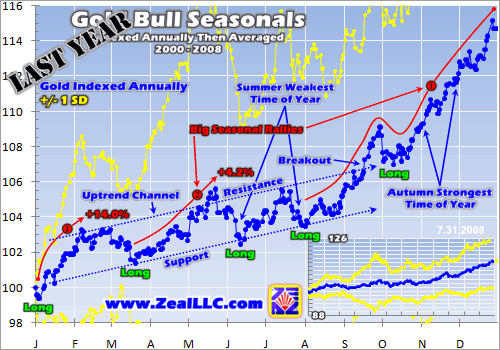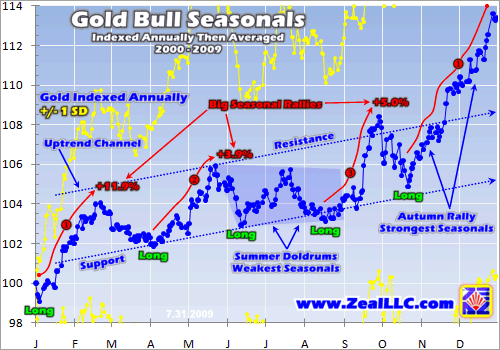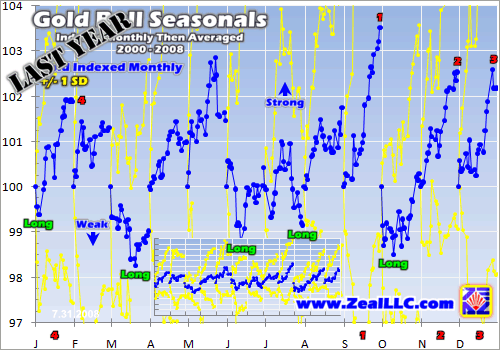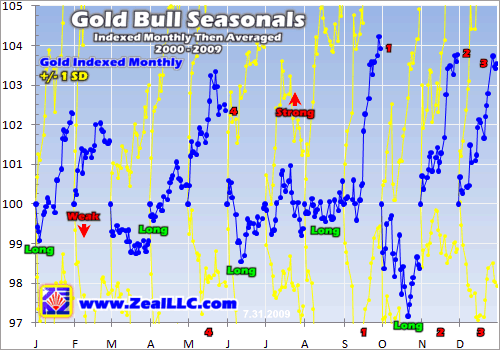|
|
|||||||
|
|
|
|
|
|
|
|
|
|
Gold Bull Seasonals 4 Adam Hamilton August 28, 2009 2831 Words
New gold investors are often surprised to learn that gold prices have a heavy seasonal component. Seasonality makes intuitive sense for commodities inexorably tied to orbital mechanics, like wheat. Their annual late-summer harvest really increases supply. But why should gold, which is mined evenly and continuously throughout the year, have big price swings governed by the solar calendar?
Unlike the supply-driven seasonality in soft commodities, gold’s seasonality is demand-driven. Across the globe, surges in gold demand tend to clump around end-of-financial-year cash surpluses and festival seasons. This is not just an Asian phenomenon, it is even true in the modern West. Gold’s well-established seasonality creates tailwinds that make certain times of the year exceptionally bullish.
And today we are entering gold’s strongest seasonal period. Autumn is a very exciting time for investors and speculators long anything in the precious-metals complex. Gold strength doesn’t only benefit the Ancient Metal of Kings, but the whole PM ecosystem which mirrors (and amplifies) gold’s every move. This includes gold stocks, silver, and silver stocks. Autumn is the best time of the year to be long PMs.
So each year heading into autumn, I revisit and update my gold-seasonality research thread. I want to know if anything has changed, if the past year’s events conspired to make gold’s seasonality stronger or weaker. Now this is more important than ever given this past year’s wild gold volatility. Through its impact on the US dollar, the stock panic drove extreme gold swings unlike anything yet seen in this gold bull.
But as always, before we delve into gold seasonality an important caveat is in order. While seasonal influences are quite tradable, seasonality is always merely a secondary driver. Technical extremes that spawn sentiment extremes (excessive greed or fear) can easily override seasonals. I think of seasonals like prevailing winds. While you don’t need a tailwind to drive your car down the highway, it is certainly nice to have one.
Most futures analysts, when they study seasonals, choose a super-long period of time like the past 15 or 30 years to crunch the numbers. I prefer an alternate approach. Prices behave quite differently in secular bulls than in secular bears. So I’m interested in pure gold-bull seasonals undiluted by the preceding gold bear. It is today’s secular gold bull I’m trading, and I do this research to help me make superior trades.
My methodology is simple. Since 2000, each calendar year’s gold action is individually indexed. The first close in January of each year is assigned a value of 100, with the percentage changes in the rest of the year moving the index accordingly. Indexing makes all years’ percentage changes perfectly comparable regardless of gold’s rising general price levels over time. Then all these annual indexes are averaged together.
The resulting averages are plotted over a generic calendar year. Since the actual daily datapoints are more important than the lines connecting them, I rendered them with large dots. In addition, standard-deviation bands are included. The larger the standard deviation, the more dispersed the underlying data is so the less predictive value it has. Averaging 10 and 90 or 45 and 55 both yield 50, but as a speculator I have much more confidence the tighter second group will have better odds of being relevant to my trades.
And since the stock panic’s impact on gold created such an epic discontinuity over the past year, I’m including two sets of charts in this essay. The first, marked “Last Year”, is from Gold Bull Seasonals 3 with data running until July 2008. They are the pre-panic control group. The second set is the new charts current to July 2009, including the crazy panic period. The insane panic volatility altered seasonals like nothing else could.
Let’s first examine the panic year’s influence on gold-bull seasonality. While the general seasonal uptrend is still very much intact, some months’ tendencies were stretched and distorted by the panic. The February seasonal rally grew considerably larger, extended by the strong hedge-fund GLD buying this past February. May’s rally was also extended, starting off a slightly lower base and rallying to a higher average apex.
The lackluster summer doldrums remained intact of course, but the September rally was altered considerably by last September’s wild gold volatility. Now gold moves into September a bit lower, its September spike starts a bit later, but then it rockets up to its late-September interim high much faster. And the subsequent October pullback before the big seasonal buying in November and December is also much more pronounced.
These changes may seem subtle as you study both charts, but they are really quite striking. Adding an additional 12 months to 103 months of past data would hardly change anything normally. Its influence is usually just too minor to affect the long averages. But gold’s giant panic swings, both its anomalous plunge with the stock markets and its subsequent quick recovery to pre-panic levels, altered the averages considerably over the past year.
Still, gold’s evolving seasonality curve didn’t affect the resulting trading tactics much at all. Every seasonal trend we’ve played with much success in past years still exists today, albeit in altered shapes. In particular, the best times of the year to add new long positions in precious metals only changed by a week or two if at all. There are still 5 seasonally-optimal times to buy gold, silver, and PM stocks noted above.
The summer doldrums are still the weakest time of the year for gold, when it tends to consolidate sideways. And autumn is still the strongest time of the year for gold, when major buying coalesces all over the world which tends to drive big gold price gains. One key tactical change I did make thanks to this past year’s impact on seasonality is to break gold’s big autumn rally into two components instead of a single extended one.
In past years, both gold’s September rally and October pullback were less extreme. And they’ll probably be less extreme again in the future too, since the panic’s impact on gold volatility in September and October of last year was so anomalously atypical. But for now, the October seasonal pullback has grown into an October seasonal correction. So I am breaking out the September rally into a third seasonal gold rally.
Between mid-August and late September, gold has tended to rally 5.0% on average over this secular gold bull. This is an exceptionally large rally for such a short span of time and is well worth playing. Its major demand-side driver is the Asian harvest. All of continental Asia sits in the northern hemisphere, so it enjoys the same crop seasons as we do in the States. After Asian farmers sell their harvests and figure out how much surplus income they generated in the year, they often plow some of their savings into gold bullion.
Provocatively, a typical seasonal rally this year would be far more bullish than normal. Why? Hovering around $950 today, a 5% September run would boost gold to just under $1000. And once gold breaks decisively above $1000, a huge psychological milestone in the West, major mainstream investment buying should flood in. It’s pretty amazing to consider that small-scale yet widespread harvest-surplus gold buying half a world away could drive the long-awaited $1000 breakout this autumn.
By the end of September, most of this post-harvest investment buying is tapering off. Prior to the panic, the early-October falloff in gold prices wasn’t anything exciting. And last year’s brutal 20% gold plunge in under 4 weeks in October that skewed this seasonality curve had nothing to do with Asian harvest. Gold was plunging simply because the extreme stock-market fear was driving major safe-haven dollar buying. So in future years this newly-deepened early-October correction will probably gradually moderate again.
The biggest seasonal gold rally of the year by far ignites in mid-October and runs without respite until mid-February. It is the global festival season, a time when gold has soared 11.9% higher on average since 2000. Statistically at least, you could capture most of gold’s gains for an entire year solely by being deployed over this impressively bullish span. This year, with $1000 hanging in the balance, could be one heck of a festival season.
Festival season kicks off in India, the world’s largest gold consumer. Weddings in India are a huge deal, and most marriages are arranged by the families. Couples typically get married during the autumn festivals like Diwali. Indians believe getting married in festival season increases marriages’ odds of success, longevity, happiness, and good luck. The families of Indian brides give them wedding gold in the form of intricate 22-karat jewelry. This dowry is not only beautiful adornment, but gold’s intrinsic value helps secure the bride’s financial future and independence within her husband’s family.
Now it is certainly true Indian gold demand has been down considerably this year. Indians are very price-sensitive and like to buy on pullbacks, yet gold has held pretty solid in the $900s since February. Some analysts argue that Indian gold demand will continue to fall, but I really doubt it. If you know any Indians, or have traveled to India in the autumn, you know how important weddings are. And with 1.2b people, there will never be a shortage of families buying gold for their beloved daughters’ weddings.
In normal years, something like 40% of India’s entire annual gold demand occurs during the short autumn wedding season! And this year, since Indian gold buying has been light and last year’s extreme market chaos certainly delayed some wedding plans a year, I expect to see a giant surge in catch-up buying. It never ceases to amaze me that Indian brides’ dowries are the biggest seasonal driver of gold investment in the world!
Many Western investors marvel at Indian-wedding gold buying, seeing it as a quaint anachronism out of place in the modern world. But this perception couldn’t be farther from the truth. Festivals are just as important here in the West. As Indian wedding season fades in late November, the holiday season spins up in the States and Europe. A big portion, if not the majority, of annual discretionary spending in the West occurs between Thanksgiving and Christmas. It’s our festival season!
There is a huge surge in gold demand as holiday dollars flow into jewelry gifts for wives, girlfriends, daughters, and mothers. A large chunk of Western jewelry demand is concentrated into this intense frenzy of buying that essentially encompasses December. There is also an investment component. Near the end of the year, bonuses are paid and like Asian farmers we all figure out how much surplus income we are likely to have. A small, yet growing, fraction of Westerners then buy some gold with their surplus.
But this seasonal rally doesn’t die after Christmas in January, its driver just shifts. Unlike our Western calendar solely driven by solar cycles, the Chinese calendar is heavily influenced by lunar cycles. So Chinese New Year typically falls between late January and mid-February on our Western calendar. And since gold is such a big part of Chinese New Year celebrations, the mighty seasonal gold rally continues into February. Gold is given as gifts and gold trinkets are used to decorate homes for the festivities.
All these fascinating cultural forces aggregated together, essentially financial-year-end surpluses and festivals, drive the biggest seasonal gold rally of the year. If gold retreats to merely $950 (on the low side) in its October pullback this year, the usual 11.9% average rally would carry it to $1065 or so by February! And you can bet your last ounce that there will be a surge in Western investment demand as soon as gold breaks decisively over $1000, so this year’s autumn seasonal rally could very well be one of the best ever.
There is another seasonal gold rally between early April and late May. While this doesn’t have a clear cultural driver like the autumn one, in observing it and trading it over the years I think it is usually Western investment demand that drives it. As spring dawns after a long winter, traders tend to get more optimistic on the markets so they start buying and drive everything higher including gold. Its 3.9% average rally is nothing like autumn’s, but it is still definitely worth trading.
My gold-bull seasonality research also continues into individual calendar months. While slicing gold action into calendar months is somewhat arbitrary since trends seldom begin or end on month-end, it still provides another perspective. So all calendar months since 2000 are individually indexed and then averaged across years, and the resulting charts help further illuminate intra-month tendencies.
Despite the wild panic-driven gold volatility, September, November, and December still retained the top three spots for the best calendar months for gold. These seasonal monthly rallies actually all grew significantly larger thanks to the panic’s influence. And the mid-autumn-rally October pullback, distorted by the panic, grew much deeper as a seasonal average. Interestingly May usurped January as the 4th best seasonal month.
Each of the optimum seasonal times to go long gold from the first chart are also rendered here on this monthly chart. The monthly seasonals certainly corroborate the annual ones. If you want to add new PM long positions, your best bets on timing are to buy in early January, early April, mid-June, mid-August (now!), or mid-October. On balance, investors and speculators have been richly rewarded in this bull by heeding these seasonals.
Before I built these new charts this week, I wasn’t sure what to expect regarding the panic year’s impact on gold seasonals. It definitely affected them far more than any other year I’ve ever seen. But I was pleased to see the panic year didn’t alter the seasonally-optimal trading times by more than a week or two at most. Gold’s seasonals remain an important secondary force, a helpful tailwind that all PM investors and speculators need to consider.
And today’s seasonals are just the icing on the cake right now. Gold fundamentals remain very bullish, with global mined supply continuing to decline despite high sustained gold prices. And central banks, long the bogeymen of the gold world, just agreed to reduce their aggregate gold sales over the next 5 years. Thanks to Washington’s reckless profligacy, big inflation is coming which will spark a surge in mainstream gold-investment demand. And the popular psychological impact of a decisive $1000 breakout can’t be overstated. Investors love to buy momentum.
If gold supply was rising and demand falling, I would not be bullish on the PM complex today no matter what the seasonals suggest. But with gold supply falling and demand rising, the strong seasonal tendencies should only amplify gold’s already-bullish outlook in the coming months. We are blessed to be witnessing an exceptional confluence of bullish drivers, of which seasonals are a welcome secondary tailwind.
At Zeal we are heavily long PM trades heading into this high-gold-potential autumn period. In our acclaimed monthly newsletter, we have 11 open PM trades right now with current unrealized gains running as high as 65%. And if gold’s strong seasonal tendencies again exert themselves this autumn, I fully expect our existing trades to soar much higher by February. Subscribe today and get deployed before the big autumn gold buying starts!
We also do deep fundamental research into gold and silver stocks to whittle down the entire publicly-traded universe to our favorites, what we believe are the very best. Over this past year, we have published fascinating and detailed comprehensive reports on our favorite 12 gold-producing stocks, our favorite 12 junior gold stocks, and our favorite 12 silver stocks. With the bullish autumn seasonals still approaching, it isn’t too late to secure your copies of these popular reports.
Each report took hundreds of hours of painstaking world-class research to craft (they average 31 pages long) which makes them fantastic bargains at just $95 each ($75 for Zeal subscribers). So if you want to learn about the best fundamentally-sound elite gold and silver stocks to consider deploying your own investment or speculation capital in, buy our reports today!
The bottom line is the gold-bull seasonals remain intact despite the wild stock-panic-driven gold volatility over the past year. While the shapes of the big seasonal rallies were altered a bit, none of the core tactics of trading these seasonal influences changed. There are times of the year when gold (and hence silver and the PM stocks) tend to languish and other times when they tend to thrive. We can ride these forces.
And today we happen to be heading into the most bullish seasonal time of the year for precious metals. Big gold buying all over the world from September to February has driven gold up about 14% on average over this span during this secular bull. Even if we only get half that this year for some reason, it will still drive gold decisively over $1000 unleashing all kinds of mainstream investment demand.
Adam Hamilton, CPA August 28, 2009 Subscribe |
|||||||
|
|
|
|
|
|
|
|
|
|
|
|
|
|
|
|||




